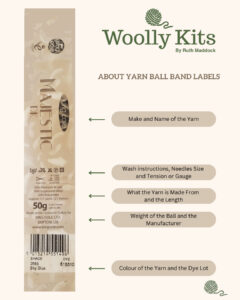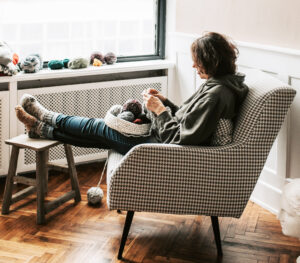Knitting is a blend of creativity and precision. As any seasoned knitter knows, achieving the correct tension or gauge for your knitting project is really important. It affects the size of the finished work and also the look and drape of the fabric.
Whether you’re a beginner or an experienced knitter, understanding and achieving the right tension/gauge can make a world of difference to your finished creations.
Let’s discover why it matters so much.
Why Tension Matters:
- Each pattern designer starts their pattern writing with a tension/gauge swatch – or square. This is usually worked over the stitch pattern, (i.e., a lace, textured or coloured pattern) but can also be worked over stocking stitch. (The tension/gauge given on the ball band label of the yarn you are going to use will always be worked over stocking stitch).

From this initial tension square all the calculations regarding the size, fit and shapings are then worked out. It’s quite a mathematical process. If you are making a garment that is fitted you will need to make sure that you are able to knit to this same tension (given in the pattern) then your finished garment will be the correct size.
- Yarn Utilization: if you don’t achieve this tension then the yarn quantities stated in the pattern may be affected and you could run out of yarn or have too much left over.
- Texture and Appearance: Tension plays a significant role in the texture of your knit fabric. If your stitches are too big and loose the fabric will be more floppy, but if they are too small and tight the fabric will be stiff, less pliable and could even appear shrunken. A consistent tension enhances the visual appeal of your knitting.
- Ease of Knitting: Knitting with the correct tension makes the process easier and more enjoyable. Loose stitches can be frustrating to work with, leading to uneven tension throughout your project. On the other hand, overly tight stitches can strain your hands and slow down your progress.
Tips for Achieving the Right Tension:
- Swatching: Before diving into your project, take the time to create a tension/gauge swatch. If the tension given by the designer is worked over the stitch pattern – you will need to replicate this in order to measure your tension correctly. Once worked you will need to measure the correct number of rows and stitches to see if they are the same as the designer’s given tension/gauge. If you have too many stitches or rows you will have to decrease your needle size if you have too few stitches or rows you will have to increase your needle size.

- Needle Selection: The pattern will always suggest a needle size but this can, and should, be altered in order to achieve the correct tension. For instance – some people know that they always knit tight, so they always increase needle size accordingly before starting their swatch. If you change the main needle size then you should also change any other needles required.
- Relaxation: Knitting is meant to be a relaxing hobby – so make sure that you are sitting comfortably and are relaxed when knitting. Every knitter has their own tension (like a fingerprint) but if you find that yours is not relaxing make a conscious effort to change it until you have a better way of knitting. As you gain experience, your tension will become more consistent. Embrace the learning process and enjoy the journey.

- Check-In Regularly: While working on your project, periodically check your tension to ensure it remains consistent. This is especially important if you’re a new knitter or are knitting a large piece that spans multiple sessions. Catching any tension issues early will save you from major adjustments later on.
- Avoid uneven stitches: by always ending at the end of a row – not halfway through.
The Joy of the Perfect Tension:
If you stick to these simple rules, then your finished garment should fit perfectly. However, most knitters just want to get knitting and many ignore the tension/gauge swatch entirely. If you do ignore this then you absolutely must measure the garment after a few inches to make sure the width and length is going to be correct. For instance: if you start by knitting the back of a sweater after a few inches or centimetres, lay the work down and measure the width to make sure that it is going to fit correctly. (You can use an existing sweater that fits well to get your measurements.)
Beginners work often has very uneven stitches because they have not settled into a consistent tension/gauge. So, if you are a beginner, I suggest that you start with a few simple home items such as pillows and cushions, little bags – or my Easy Peasy Fingerless Gloves – available as a kit or a pattern. these will not need to have a specific fit and are often satisfyingly quick to finish. The knitting practice gained from this will help to get your work flowing evenly.
Above all make sure that you enjoy your knitting!

/*54745756836*/


